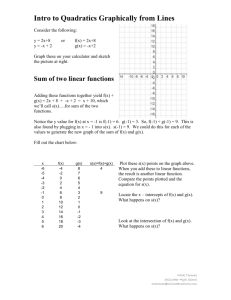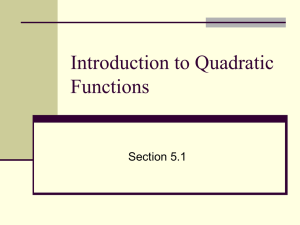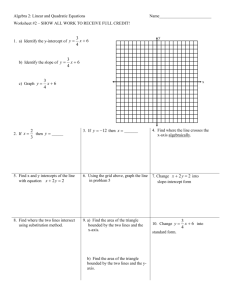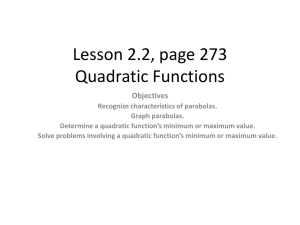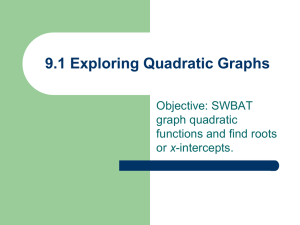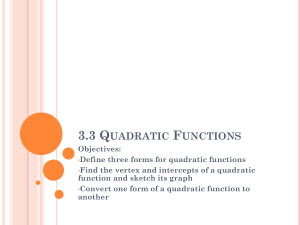Quadratic Summary
advertisement
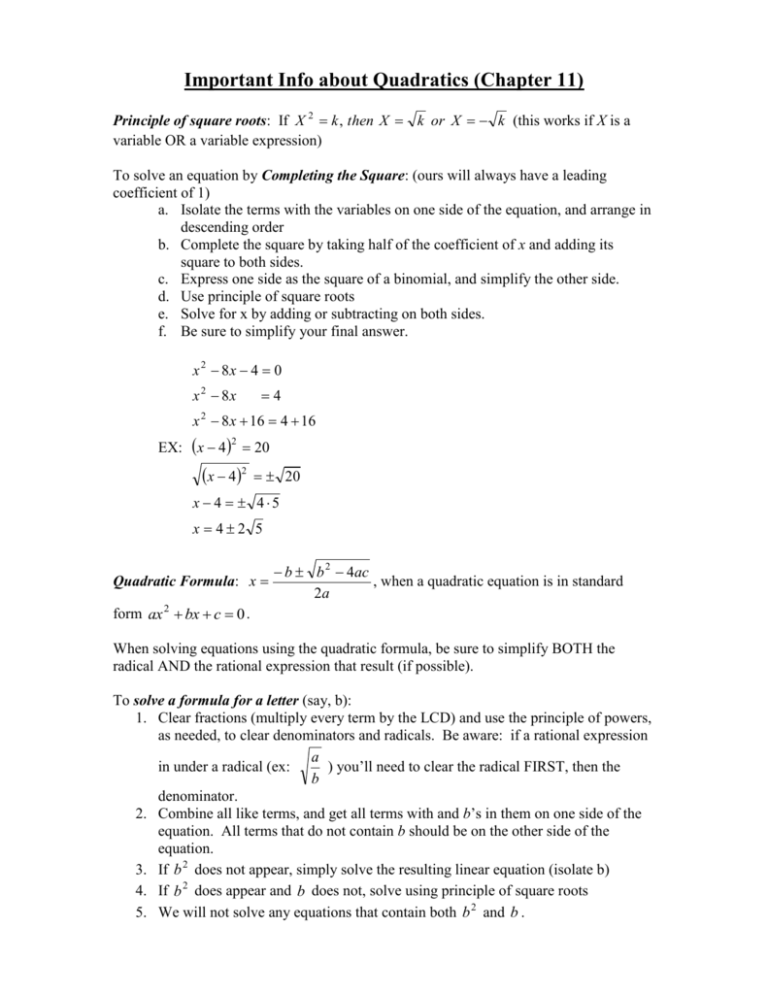
Important Info about Quadratics (Chapter 11) Principle of square roots: If X 2 k , then X k or X k (this works if X is a variable OR a variable expression) To solve an equation by Completing the Square: (ours will always have a leading coefficient of 1) a. Isolate the terms with the variables on one side of the equation, and arrange in descending order b. Complete the square by taking half of the coefficient of x and adding its square to both sides. c. Express one side as the square of a binomial, and simplify the other side. d. Use principle of square roots e. Solve for x by adding or subtracting on both sides. f. Be sure to simplify your final answer. x 2 8x 4 0 x 2 8x 4 x 2 8 x 16 4 16 2 EX: x 4 20 x 4 2 20 x 4 45 x 42 5 Quadratic Formula: x b b 2 4ac , when a quadratic equation is in standard 2a form ax 2 bx c 0 . When solving equations using the quadratic formula, be sure to simplify BOTH the radical AND the rational expression that result (if possible). To solve a formula for a letter (say, b): 1. Clear fractions (multiply every term by the LCD) and use the principle of powers, as needed, to clear denominators and radicals. Be aware: if a rational expression a in under a radical (ex: ) you’ll need to clear the radical FIRST, then the b denominator. 2. Combine all like terms, and get all terms with and b’s in them on one side of the equation. All terms that do not contain b should be on the other side of the equation. 3. If b 2 does not appear, simply solve the resulting linear equation (isolate b) 4. If b 2 does appear and b does not, solve using principle of square roots 5. We will not solve any equations that contain both b 2 and b . GRAPHING QUADRATIC FUNCTIONS: General form: f ( x) a( x h) 2 k The vertex is the point ( h, k ) (Watch your sign on the h!) The “a” describes the shape of the parabola o If a 0 then the parabola will open up o If a<0 the parabola will open down o If a >1, then the parabola will be “skinny” compared to the graph of x 2 o If a 1 , then the parabola will be “wide” compared to the graph of x 2 . The axis of symmetry is the vertical line through the vertex of a parabola about which the parabola is symmetrical (it is like a mirror: both sides of the parabola are identical with respect to this line). The axis of symmetry of a parabola is given by an equation of the form x h , where h is the same as the h of the vertex. A parabola always has either a maximum or a minimum function value: It will have a minimum value if the parabola turns upward (e.g., if a>0), and will have a maximum if the parabola turns downward (e.g., if a<0). The max or min function value comes from the y-coordinate, or k coordinate in the vertex. Finding intercepts: o To find the y-intercept, let x 0 and find the value for f (x) . In a quadratic function f ( x) ax 2 bx c , the y-intercept is always (0, c) o To find the x-intercept, let f ( x) 0 and solve the resulting quadratic equation for x. Use factoring or the quadratic formula. BE AWARE: The graph of a quadratic function may have 0, 1, or 2 x-intercepts. o Zero x-intercepts: When finding the x-intercepts as described above, if the solution of the quadratic turns out not to be a real number (there appears a negative under the radical), the parabola will not cross the x-axis. o One x-intercept: If the quadratic equation results in only one solution (in other words, the quadratic was a perfect square), there will be only 1 x-intercept, and the vertex of the parabola will be on the x-axis. o Two x-intercepts: If the quadratic equation results in 2 real solutions (either rational or irrational), the parabola will cross the x-axis twice. Different forms of quadratic functions f ( x) a( x h) 2 k is ideally suited for graphing; for finding the vertex, the axis of symmetry, and the maximum or minimum function value. f ( x) ax 2 bx c is ideal for finding x- and y-intercepts. From this form, we can still figure out the general shape of the parabola from the value of a, but finding the vertex (and associated information) is more difficult.
